
December 21, 2023
Technology has always had a way of rapidly evolving, often faster than we can keep up. Just look at how far tech has come in the last decade. 3G and 4G networks burst onto the scene. Smartphones became more popular, and by 2022, the average household was home to 22 digital devices.
Fast-forward to 2023, and we’re in the era of AI. Tools like ChatGPT, Dall-e, Claude.ai, and more have thrown a curveball at traditional business processes, forcing businesses to adapt faster than they’d probably like.
In this article, we’ll be focusing on the concept of prompt engineering in AI. We’ll cover everything from its definition to how it’s being used to help businesses streamline their processes and what to expect in 2024.
What is a prompt?
A prompt is a piece of text you enter into an AI program (like ChatGPT) to perform a specific task. A prompt can be anything from asking it to describe an ETL pipeline to more complex tasks like creating full stories and summarising complex articles or documents for easy reading.
The quality of the prompt determines the quality of the response. It’s like having a fantastic interviewer ask great questions to an interviewee. The more specific the prompt, the more specific (and often better) the response and output.
What is prompt engineering?
As mentioned, the quality of the prompt determines the quality of the response. Simple questions like asking, “What is a unified data warehouse?” will generate a response that answers this question in a way that the AI believes is best. What we mean by this is that no further parameters have been set.
For example, if this same question was asked but an additional prompt saying, “Please answer in a conversational tone, in less than 150 words and use short, snappy sentences,” then ideally, its output would be tailored to these instructions.
In essence, prompt engineering is about understanding AI’s architecture to create prompts that consistently deliver the best results and outputs.
How prompt engineering works
Understanding every intricacy of how prompt engineering works would be difficult to summarise in one post, especially considering it’s constantly evolving and has only been around for a year!
We outlined how a prompt like “Please explain what a medallion data pipeline is” will generate a straightforward answer, but how does it do this?
At its core, prompt engineering can be narrowed down to four key principles.
Model architectures
A model architecture refers to the design and structure of an artificial intelligence model. ChatGPT uses a model architecture known as a “transformer”—it’s like a blueprint for how a computer understands language. Bard (Google’s version of ChatGPT) is also built on a transformer architecture. Both ChatGPT and Bard are Large Language Models (LLMs).
Both allow these separate AIs to handle tonnes of complex information and data as well as understand and interpret context through self-attention mechanisms (the process of weighing the importance of different words in a sequence relative to each other).
To create the “best” prompts—and get the best responses—prompt engineers will have to have a solid understanding of model architectures.
Model parameters
The sheer number of parameters that AI programs like ChatGPT and Bard have is immense.
We’re talking millions, if not billions, of parameters. The more the prompt engineer knows about a model’s parameters, the better they will be at creating a prompt that generates the best outcome.
Training data
LLMs learn from huge sets of data, breaking input into smaller parts called tokens. The way we break them (like by words or byte pairs) affects how the model understands requests. For example, changing how a word is split can give different results.
The entries “spaceship” and “space, ship” would bear different results for an AI image generator. One may be of a spaceship in space. Meanwhile, the other would likely generate an image of a seafaring ship in space.
Temperature and top-k insights
When AI models create responses, they use methods like temperature setting and top-k sampling to control randomness and diversity.
Temperature influences how varied the outputs are; a higher temperature makes responses more diverse but less accurate, whereas top-k sampling limits the choices to the top-k—most likely next words—adding control.
For example, with a high temperature, asking a model about colors might give a broader range like “blue, red, sunny.” In contrast, a lower temperature might offer more focused responses like “blue sky.”
Prompt engineers tweak these settings to get desired results, finding a balance between creativity and accuracy in AI-generated content.
What to know about prompt engineering in 2024
2023 was an AI whirlwind—from using it to automate some of the more mundane tasks in our jobs to transcribing conversations in a small business VoIP phone system to diagnosing brain tumors. There’s no doubt AI has made much of our working lives easier.
As we step into 2024, the world of AI and prompt engineering is showing no signs of slowing down. Here are some of the main things to know about prompt engineering going into next year.
1. It’s not going anywhere
AI is here to stay, and that’s good news for prompt engineers. Companies have already started making changes to their hiring practices with AI in mind, with roles in prompt engineering high on this list.
According to a McKinsey survey, around 7% of people surveyed whose companies started using AI said they hired someone with prompt engineering skills in the last year.
Following this, more than two-thirds expect their organizations to increase their AI investment over the next three years. However, this isn’t necessarily bad news for current employees, as many companies will reskill their existing employees as part of their career development path as opposed to replacing them.
2. Demand across industries will increase
As more and more people accept AI’s integration with our day-to-day lives, the demand for prompt engineers will likely increase. The best SaaS management platform will use prompt engineering to summarize meeting notes and update projects, and this will continue to expand into other industries like healthcare and entertainment.
3. There will be more prompt engineer career options
There are already jobs being posted on websites, including LinkedIn and Indeed, revolving around the subject of prompt engineering. As AI continues to develop, the need for people who know how to use it properly will follow suit.
Industries like digital marketing and advertising will likely be searching for experienced prompt engineers going into 2024. The role itself will likely be broad and take many forms. For example, some prompt engineers may be asked to work with chatbots to enhance their support functions to provide better responses and services to real customers.
Plus, on the freelance front, prompt engineering will likely join the freelancer category. Just as there are freelance designers and copywriters, there will now be room for freelance prompt engineers.
The demand for this will likely be high, especially for businesses that choose to outsource their prompt engineering needs instead of hiring new staff.
4. It will continue to deal with ethical implications
Despite the apparent benefits that AI has brought with it, there are also plenty of problems. Data safeguarding issues, real-world bias, discrimination, inaccurate information, and general ethical concerns still somewhat tarnish AI’s reputation.
As we move forward in 2024, it is crucial that prompt engineers (and those that use them) follow best practices and guidelines to ensure ethical prompting.
5. There will be both challenges and opportunities
As with any new piece of tech or trending interest, it will present challenges and opportunities. One of which will be learning how to use and navigate the increase of prompt engineering programs. ChatGPT, Bard, and Bing Chat are among the leaders of this technology, but since their introduction, more spin-offs have popped up.
Prompt engineers will need to have their fingers on the pulse to ensure they don’t get left behind when it comes to learning and adapting to this ever-evolving technology.
Another issue will be the battle between bias and fairness. Prompt engineers will have to be skilled writers and researchers to accurately assess the output of a prompt. For example, a chef with no experience wouldn’t be able to distinguish a great dish from a bad dish due to lack of experience.
Creators of AI platforms must also play a bigger part in ensuring that the outputs of their creations are as accurate and unbiased as possible.
6. Adaptation is crucial
Prompt engineering isn’t going anywhere (at least not in 2024). As more models are introduced into the world, more industries will adapt them into their strategies, and the need for prompt engineers to effectively utilize them will increase.
Prompt engineers will make sure these models are easy to use and relevant to the user. Plus, as more and more people begin to use AI, prompt engineers’ roles will evolve.
For example, they’ll likely be tasked with creating easy-to-use interfaces, crafting user-friendly prompts that anyone can understand, adapting to future trends, and ensuring AI works for its users.
Prompt engineering: Bridging the gap between humans and AI
AI burst onto the scene last year and completely changed the landscape of technology, revolutionizing how we approach tasks, make decisions, and interact with information.
While prompt engineering can be seen as a branch of AI, let’s not underestimate the importance of its role. Prompt engineering essentially creates the bridge between human intent and AI’s understanding of that intent. Without the right prompts, we’re less likely to obtain the right responses.
With the focus and demand for LLM models sure to increase going into 2024, prompt engineer jobs and skillsets will likely follow suit. At the core of this is effective communication, and without a seasoned prompt engineer at the helm, achieving this will become difficult.
Recent Posts

August 27, 2025
How to Find the Right Learning Path When You’re Switching to a Tech Career
See post

August 22, 2025
Developer News This Week: AI Speed Trap, GitHub Copilot Agents, iOS 26 Beta Updates & More (Aug 22, 2025)
See post

August 08, 2025
Developer News This Week: GitHub GPT-5, VS Code 1.103 & Chrome 139 (Aug 8, 2025)
See post




